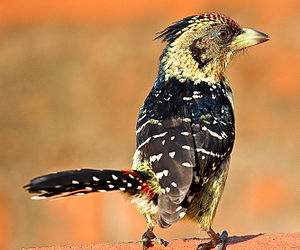Crested bearded bird
| Crested bearded bird | ||||||||||||
|---|---|---|---|---|---|---|---|---|---|---|---|---|

Crested bearded bird ( Trachyphonus vaillantii ) |
||||||||||||
| Systematics | ||||||||||||
|
||||||||||||
| Scientific name | ||||||||||||
| Trachyphonus vaillantii | ||||||||||||
| Ranzani , 1821 |
The crested barbet ( Trachyphonus vaillantii ), also blackbacks Barbet called, is a bird art from the family of the African barbets. The species is only found in southern Africa. Several subspecies are distinguished. The IUCN classifies the crested bearded bird as not endangered ( least concern ).
Appearance
The males of the nominate form reach a wing length of 9.5 to 10.5 centimeters. The tail is between 8.0 and 9.4 inches long. The beak length is 2.0 to 2.6 centimeters. Females have similar body measurements. There is no noticeable sexual dimorphism . Some females are only slightly paler in color than males and have less red in their plumage.
The head is yellow with a few red spots and stripes. The black feather base is sometimes visible. The feather hood on the back of the head and the neck are black, at the level of the ear covers there is a black, indistinct crescent-shaped spot. The top of the body is glossy black with yellowish to white transverse bands. The rump is lime yellow. The upper tail-coverts are black with red feather tips. The control feathers are black to black-brown with a narrow white transverse band. There is a large, shiny black shield-shaped spot on the front breast. In most individuals this shows silvery to silvery reddish points. The rest of the underside of the body is yellow, but reddish stripes on the chest and sides. The featherless skin around the eyes is black, the eyes are red to red-brown. The beak is usually horn colored with a darker tip. The legs and feet are brown or gray to black.
Young birds are a little more dull in color than the adult birds. Overall, they appear a little more brownish, the yellow is less intense.
It can only be confused with bird species from its own genus: The hooded bearded bird differs from the flamehead bearded bird by its striking feather hood. This species also has a yellowish bill, like the earmarked bearded bird and the yellow-billed bearded bird .
Distribution area and habitat
The crested bearded bird occurs from northern Angola via the DR Congo , southwest Uganda, Rwanda, northeast Namibia, north and east Botswana, via Zimbabwe and Mozambique, to the east of the South African Republic. The altitude distribution ranges from sea level to altitudes of 2250 meters.
The habitat are thickets, forests and bushland along rivers. The most common are crested beards in open Mopane forests and the miombo , a type of forest savanna.
Way of life
The crested bearded bird looks for food mainly on the ground and hangs out between trees, bushes and termite mounds. Occasionally it also flies into the branches of trees and bushes, where it sometimes hangs upside down on the branches like tits. On the ground it moves mostly hopping. The food spectrum includes fruits such as figs, berries and guavas, as well as various seeds. Insects also play a major role. It eats grasshoppers, beetles, wasps, cockroaches and termites, among other things. In South Africa it can often be seen in bird feeders.
He is not as social as other bearded birds. Usually it is only associated with the partner bird and sleeps with it, for example, in caves that it has dug itself or in the abandoned nests of other birds such as the Cape Swallow ( Cecropis cucullata ) or the Mahali weaver ( Plocepasser mahali ). In places where the species is not pursued by humans, the crested bearded bird is an extremely tame bird that approaches humans.
Crested bearded birds are cave-breeders that usually breed in freshly made tree hollows each year. They prefer soft wood species such as the poplar species Populus wislizenii . Usually the nests are at a height of one to four meters above the ground. They also occasionally use artificial nest boxes. The clutch consists of three to four eggs with a glossy white surface. The laying interval is 24 hours, and incubation begins with the second or third egg. Both parent birds breed, but the female has the greater share of the breeding business. It was observed that after the loss of the partner, the surviving crested bearded bird mates again very quickly and infanticide can then occur. In both cases observed, the new partner destroyed the eggs or killed the nestlings and then began brooding again. The breeding season is between 13 and 17 days. The nestling time is not exactly known and is given as 17 to 31 days. After flying out, the young birds follow the adult birds for some time. If this begins a second brood, the young birds remain in the territory, but are no longer tolerated in the nesting cavity.
supporting documents
literature
- Lester L. Short, Jennifer FM Horne: Toucans, Barbets and Honeyguides - Ramphastidae, Capitonidae and Indicatoridae . Oxford University Press, Oxford 2001, ISBN 0-19-854666-1
Single receipts
Web links
- Trachyphonus vaillantii inthe IUCN Red List of Threatened Species 2013.2. Listed by: BirdLife International, 2012. Retrieved February 2, 2014.

